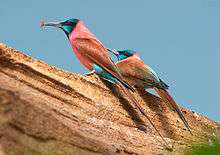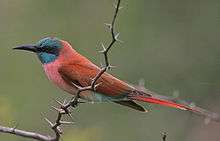Northern carmine bee-eater
| Northern carmine bee-eater | |
|---|---|
 | |
| Scientific classification | |
| Kingdom: | Animalia |
| Phylum: | Chordata |
| Class: | Aves |
| Order: | Coraciiformes |
| Family: | Meropidae |
| Genus: | Merops |
| Species: | M. nubicus |
| Binomial name | |
| Merops nubicus Gmelin, 1788 | |
The northern carmine bee-eater (Merops nubicus) is an African near passerine bird in the bee-eater family, Meropidae. Alternative common names include the carmine bee-eater or the Nubian bee-eater. It is closely related to the southern carmine bee-eater where the throat is carmine (instead of blue).
Distribution
It is native to Benin, Burkina Faso, Cameroon, the Central African Republic, Chad, the Democratic Republic of the Congo, Côte d'Ivoire, Eritrea, Ethiopia, Gambia, Ghana, Guinea, Guinea-Bissau, Kenya, Liberia, Mali, Mauritania, Niger, Nigeria, Senegal, Sierra Leone, Somalia, Sudan, Tanzania, Togo and Uganda. It occurs as a vagrant in Burundi.[1]
Ian Smalley and his colleagues suggested that the distribution of the northern carmine bee-eater is tightly linked to the presence of secondary loess deposits throughout Africa.[2]
Description
This species, like other bee-eaters, is a richly colored, slender bird, predominantly carmine in color, except for a greenish blue head and throat and distinctive black mask. This species has red eyes, a black, pointed, decurved beak, and elongated central tail feathers.[3]
The sexes are similar in appearance, and the juveniles can be distinguished from adults by their lack of elongated central tail feathers and the pinkish brown coloration of their mantle, chest to belly, and flanks.[4]
Behavior
Breeding
They nest in large colonies in cliffs, usually near river banks, where they use their bills to dig long horizontal nesting tunnels, often eight feet or more in length. Some colonies may consist of just a few nests while others accommodate hundreds of breeding birds. The same site may be used for several years and then the colony may all move to another location. Occupied nests accumulate a black litter of insect remains and smell strongly of ammonia. Three to five eggs are laid per clutch.[4]
Feeding
Their diet is made up primarily of bees and other flying insects, such as flying ants, grasshoppers and locusts. The main hunting strategy of bee-eaters is to keep watch for flying insects from a perch, and then snatch them out of the air using their beaks, before returning to the perch.[4]
Call
The call is a deep, throaty tunk in flight; a series of rik notes when perched.[3]
References
- 1 2 BirdLife International (2012). "Merops nubicus". IUCN Red List of Threatened Species. Version 2013.2. International Union for Conservation of Nature. Retrieved 26 November 2013.
- ↑ McLaren, S.; et al. (2014). "Loess and Bee-Eaters II: The ‘loess’ of North Africa and the nesting behaviour of the Northern Carmine Bee-Eater (Merops nubicus Gmelin 1788)". Quaternary International. 334-335: 112–118. doi:10.1016/j.quaint.2014.01.040.
- 1 2 Fry, H.; Boesman, P.; Kirwan, G.M. (2016). "Northern Carmine Bee-eater (Merops nubicus)". Handbook of the Birds of the World Alive. Lynx Edicions, Barcelona. Retrieved 16 October 2016.
- 1 2 3 Fry, C. Hilary; Fry, Kathie (2010). Kingfishers, Bee-eaters and Rollers. Bloomsbury Publishing. pp. 285–287. ISBN 978-1-4081-3525-9.
External links
- Northern Carmine Bee-eater in Zoo Basel/Switzerland Zoo Basel (dt.) hear it calling
- Merops nubicus at zipcodezoo.com

